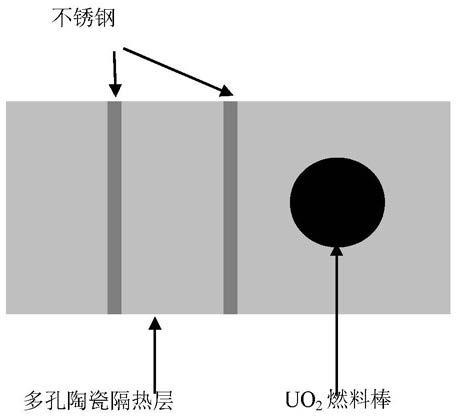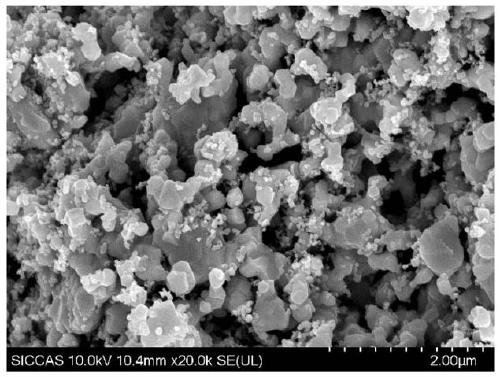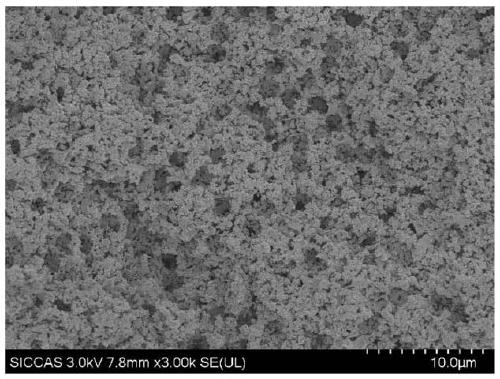Porous rare earth titanate heat-isolating material and preparation method and application thereof
A technology of rare earth titanate and thermal insulation materials, applied in the field of materials, can solve problems such as volume expansion and structural damage, and achieve the effects of reduced absorption, low stability, and low thermal conductivity
- Summary
- Abstract
- Description
- Claims
- Application Information
AI Technical Summary
Problems solved by technology
Method used
Image
Examples
preparation example Construction
[0041] As an example of a preparation method of a porous rare earth titanate-based ceramic heat insulating material, the composition of the porous rare earth titanate based ceramic heat insulating material is Re 2 TiO 5 and Re 2 Ti 2 o 7 , R stands for Y and lanthanide rare earth elements, using a solid-phase synthesis process, the steps are as follows: the compound containing titanium, including TiO 2 , Ti 2 o 3 and Ti powder, etc., are mixed with rare earth oxides, hydroxides, nitrates, etc. according to a certain molar ratio, and then mixed with water or liquid organic solvents for ball milling or sand milling. The mixing time is 0.5-48 hours. Add a certain proportion of pore-forming agent into the slurry and continue mixing for 0.5-5 hours. The slurry is dried at 60-100°C or pre-filtered and then dried, and sieved (the mesh size of the sieve can be 80-200 mesh.) to remove large particles. The obtained powder is pressed into tablets, and debinding and sintering are ...
Embodiment 1
[0045] Example 1 Y 2 TiO 5 Porous insulation ceramics
[0046] Titanium dioxide powder (10g) and yttrium oxide were mixed in a molar ratio of 1:1, citric acid (0.2g) was added as a dispersant, water (30g) was used as a ball milling medium, and zirconia balls were used to mill for 4 hours. In the above slurry, add PMMA that accounts for 50% of the volume ratio of all solid raw materials as a pore-forming agent, continue ball milling for 1 hour, and then dry at 80°C. After sieving, dry pressing and cold isostatic pressing, the biscuit is obtained. The green compact was subjected to debinding treatment at 600°C for 2 hours, and then sintered at 1200°C for 10 hours under air atmosphere conditions to obtain a porous yttrium titanate ceramic heat insulating material. It was made into a disc with a diameter of 50mm and a thickness of 5mm for heat insulation test, and the thermal conductivity was 0.18W / mK at 30°C. The obtained porous yttrium titanate ceramic heat insulating materi...
Embodiment 2
[0047] Example 2 Y 2 Ti 2 o 7 Porous insulation ceramics
[0048] Ti powder (50g) and yttrium oxide were mixed according to the molar ratio of 2:1, polyethylene glycol (5g) was added as a dispersant, ethanol (50g) was used as a ball milling medium, and a sand mill was used to circulate the mixture for 1 hour. In the above slurry, add polystyrene balls with a volume ratio of 70% as a pore-forming agent, continue sanding for 0.5 hour, and then dry at 60°C. After sieving, dry pressing and cold isostatic pressing, the biscuit is obtained. The green body was subjected to debinding treatment at 500°C for 1 hour, and then sintered at 1300°C for 5 hours under an oxygen atmosphere to obtain porous yttrium titanate (Y 2 Ti 2 o 7) Ceramic insulation material. It was made into a disc with a diameter of 50mm and a thickness of 5mm for heat insulation test, and the thermal conductivity was 0.12W / mK at 30°C. The obtained porous yttrium titanate ceramic heat insulating material had a ...
PUM
| Property | Measurement | Unit |
|---|---|---|
| pore size | aaaaa | aaaaa |
| size | aaaaa | aaaaa |
| particle size | aaaaa | aaaaa |
Abstract
Description
Claims
Application Information
 Login to View More
Login to View More - R&D
- Intellectual Property
- Life Sciences
- Materials
- Tech Scout
- Unparalleled Data Quality
- Higher Quality Content
- 60% Fewer Hallucinations
Browse by: Latest US Patents, China's latest patents, Technical Efficacy Thesaurus, Application Domain, Technology Topic, Popular Technical Reports.
© 2025 PatSnap. All rights reserved.Legal|Privacy policy|Modern Slavery Act Transparency Statement|Sitemap|About US| Contact US: help@patsnap.com



